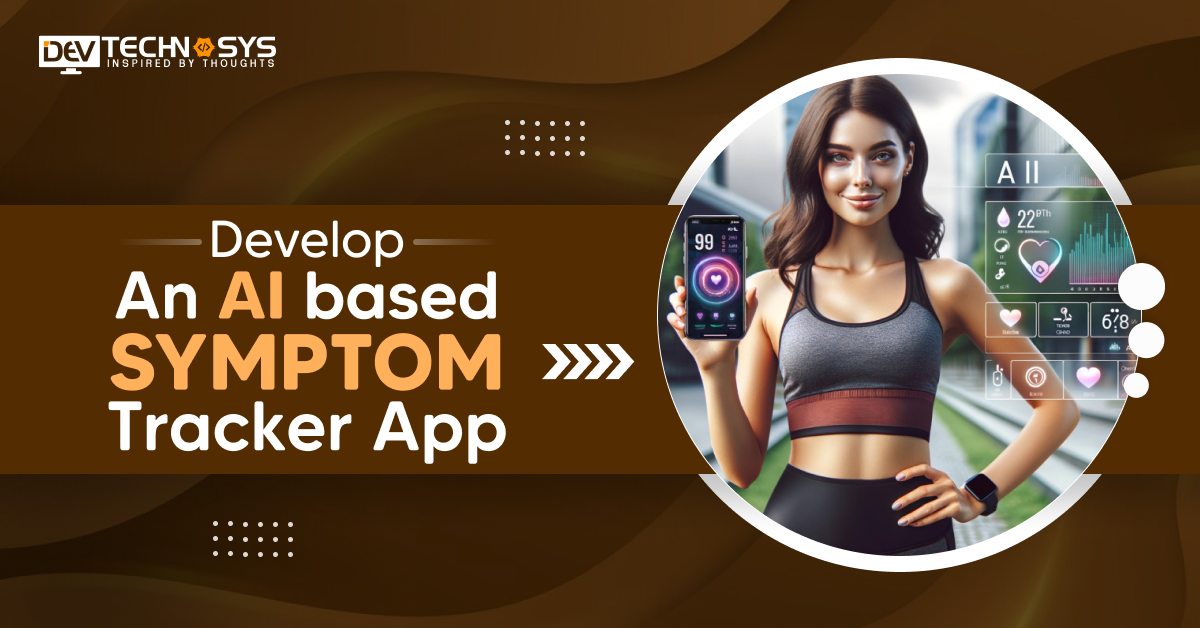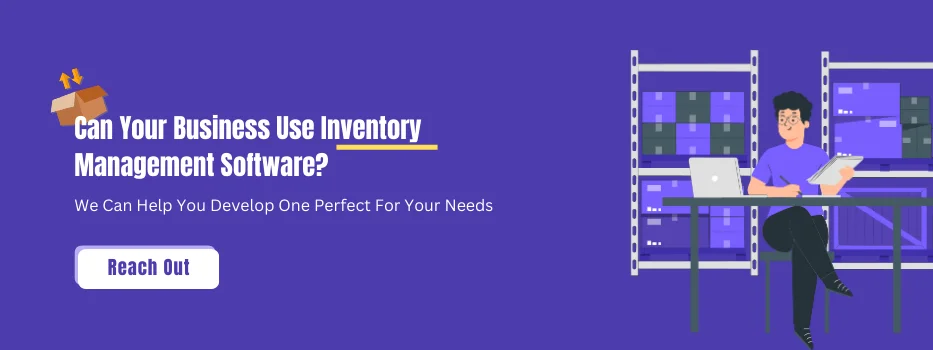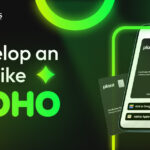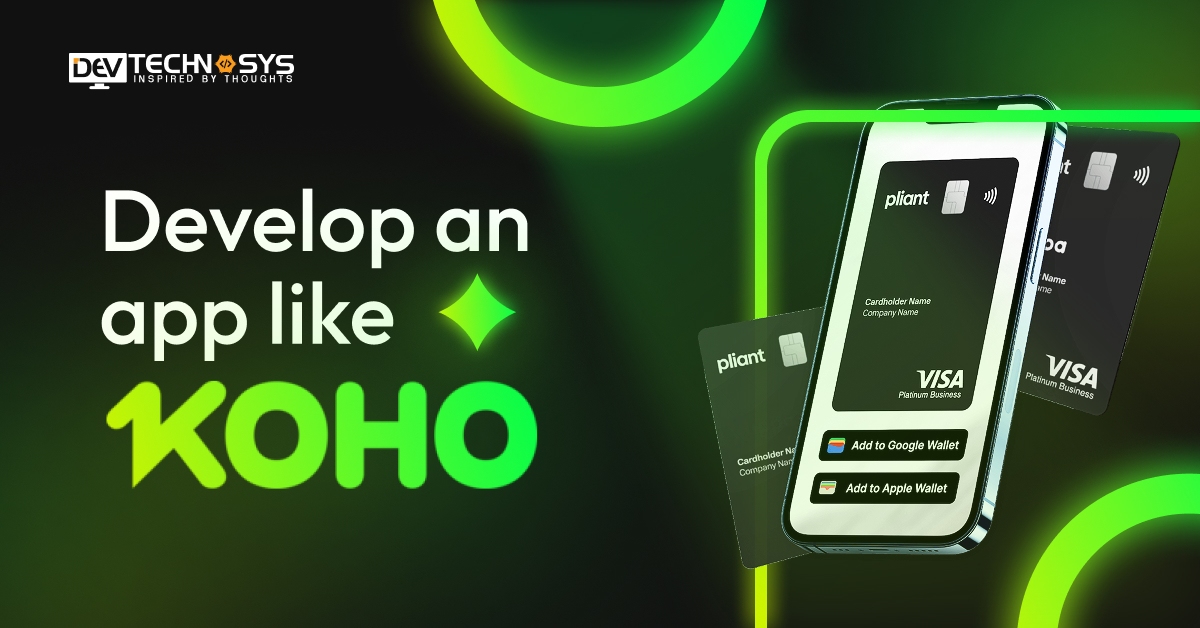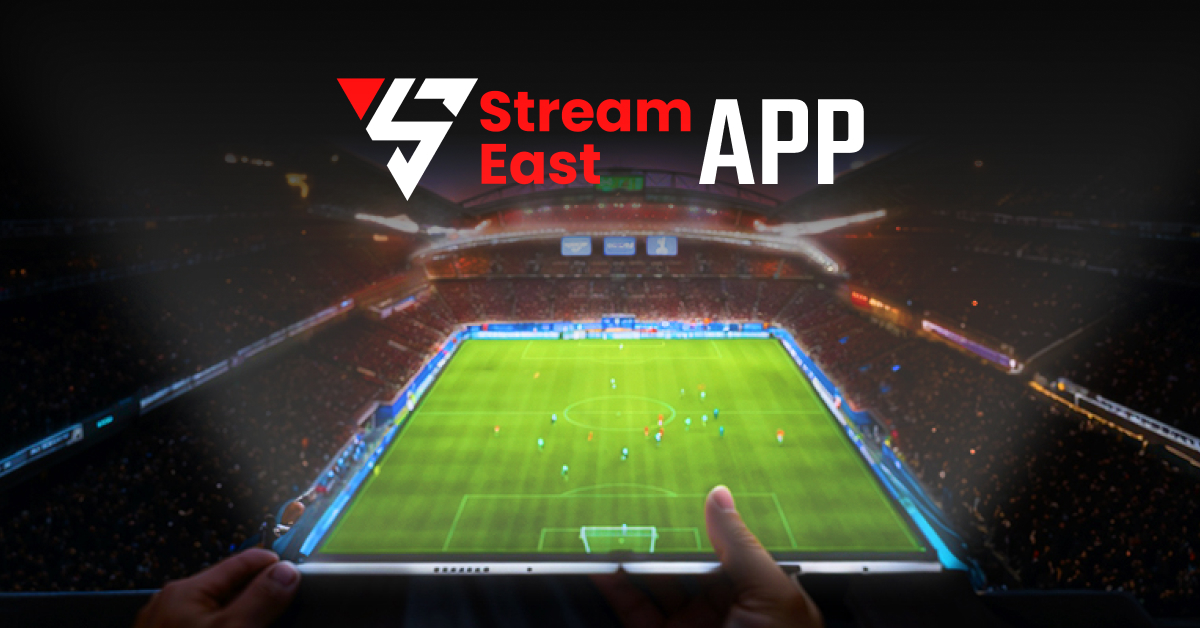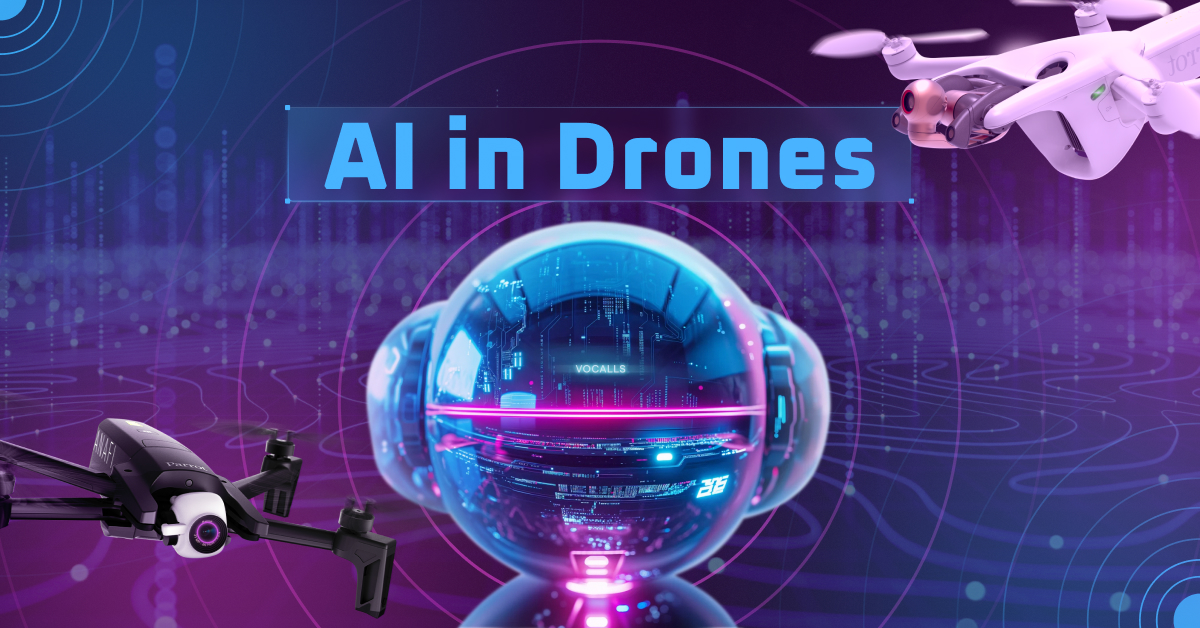Being sick is not the most exciting thing that can happen in one’s day. You have yet to learn what is happening, and guessing can be tiring. Wouldn’t it be great if you had some assistance to help you figure out what’s happening and what to do about it?
This is what drove me to create an AI-based symptom tracker application. In this blog, I will describe my personal journey, what I have learned, and how such an application was created.
I will outline the major features of this kind of application, starting from the idea generation to the deployment of the last possible step of the symptom tracker app.
So people, if you are someone are interested in how AI can be developed, used, or used for simply symptom recognition in technology and its impact on people’s health, this guide will help you understand how to develop a symptom tracker application that may bring positive change to people’s lives. Let’s begin!
What is An AI-based Symptom Tracker App & How Does It Work?
An AI-based symptom tracker software facilitates customers in understanding and managing their fitness troubles through artificial intelligence. This is the way it works:
![]()
1. Input Your Symptoms:
Through the medical symptom checker app, you are induced to provide details about your signs, including their depth, length, and contributing reasons.
2. AI Analysis:
The medical symptom checker app AI tests your input and compares it to a library of clinical statistics.
3. Possible Causes:
The health symptom checker app suggests viable causes or illnesses based on your symptoms.
4. Customized Advice:
The symptom checker app gives personalized guidance on self-care, how to get medical help, and advised over-the-counter pills.
5. Track Progress:
The health symptom checker app allows you to monitor your progress, communicate updates with your healthcare professional, and record your signs and symptoms over time.
Connecting with leading AI development services will help you develop an AI-based symptom tracker with notable trends and technology. So, without further ado, let’s start the symptom tracker app development.
10 Popular AI Based Symptom Tracker Apps
App Name |
Launch Year |
Available Platforms |
| Ada | 2016 | iOS, Android |
| Buoy | 2016 | iOS, Android |
| Your.MD | 2014 | iOS, Android |
| Symptomate | 2012 | iOS, Android |
| Babylon Health | 2013 | iOS, Android, Web |
| MDLIVE | 2006 | iOS, Android, Web |
| Doctor on Demand | 2012 | iOS, Android, Web |
| Teladoc | 2002 | iOS, Android, Web |
| HealthTap | 2010 | iOS, Android, Web |
| Amwell | 2006 | iOS, Android, Web |
Why Do Entrepreneurs Develop AI based Symptom Tracker App?
There are several reasons why entrepreneurs are interested in creating symptom checker artificial intelligence integrated; in this section of our blog, I have curated a guide that presents a significant return on investment (ROI) as well as makes the application attractive to investors:
![]()
1. Meeting the Existing Healthcare Challenge:
The current status of the world healthcare industry is very dynamic, with the increasing pressures on healthcare institutions. It is also vital to know the growing requirements for healthcare services that are more accessible and affordable.
The current healthcare is enhanced by machine learning app development, such as the diagnosis generator based on symptoms. It enables people to easily track their health, recognize symptoms, and visit a doctor. This way, entrepreneurs can meet the population’s needs and create high revenues.
2. Applying the Effect of Artificial Intelligence:
Artificial intelligence in healthcare services can transform the healthcare sector by giving out relevant and timely health information. Some of the benefits include the ability of the input symptoms to get a diagnosis to collect and analyze large data sets, identify trends, and provide health information specific to the user.
This ability to implement artificial intelligence will lead to enormous enhancements in the efficiency of healthcare and attract investors with visionaries who see the future of this technology.
3. Creating a Loyal Customer Base:
When entrepreneurs offer their customers something that will benefit their health, they are most likely to become loyal to the entrepreneur. Such users will be more likely to be regular customers who can contribute to the revenue stream through subscribing to premium services, buying items within the mobile application development, or viewing ads.
This also means that the artificial intelligence symptom checker will have many users, which is a good thing for investors, especially those interested in companies with a large customer base.
5 Steps to Develop an AI-Based Symptom Tracker App
Symptom tracker application development requires the involvement of a healthcare app development company and a structured approach for successful results. Here are the key steps involved in this process to develop an AI-based symptom tracker app.
![]()
1. Define the Scope and Features:
The first step is to establish the general outline and functionalities of your on-demand app development. This involves establishing the market for the symptoms to check both potential problems in healthcare, the various symptoms it is likely to monitor, and the complexity of the artificial intelligence that is to be incorporated into the symptom tracker app development. This is because a well-defined scope will help implement the symptoms AI tracker app.
2. Choosing the Tech Stack:
The second stage is to develop an AI-based symptom tracker app., in which you must choose a technology stack for your best ai symptom checker. The resources involve the proper use of the best technology of way stack programming possible.
When languages develop like Swift, Choose good Kotlin, the and or Right scalable React Technology symptom Native, library tracker framework that AI will most suit the symptom checker AI. It will be helpful to seek input from a reputable mobile app development company to select the technology stack.
3. Design the User Interface (UI) and User Experience (UX):
In this third stage, to create an AI-based symptom tracker app, you need to discuss the user interface and the overall experience, which are the key factors in the app to track health symptoms. It is vital to know that they define some engagement and usage of the MVP app development.
Good UI design makes the interface of an application easy to use and appealing to the eye, while good UX design ensures that users are well able to navigate through the different sections of an app for tracking health symptoms.
4. Develop the AI Model:
You’re almost ready to develop an AI-based symptom tracker app, which the hired symptom tracker app development company will take overall. Your symptom users will track symptoms working chronic illness symptom tracker apps as inputs; this and should the output be AI possible skilled model conditions in that or you’ll treat them. The use of artificial learning intelligence and NLP processing, specifically language machine processing, is needed to create a proper AI model.
5. Integrate with Healthcare Providers:
Last but not least, you must create an AI-based symptom tracker app, and you must think about how your application can be linked. The symptom tracker application development needs to be linked with healthcare providers or telemedicine services in order for personnel to increase the usefulness of the consultation process through the food symptom tracker app.
App This completes the whole process of users seeking medical services. A reputable AI development company can help implement such integrations and coordinate the interaction between healthcare users and givers.
Features of AI-Based Symptom Tracker App Development
Now that we know the process to develop an AI-based symptom tracker app, you must be wondering about the features. In this section, we have covered the features that a healthcare app development must have.
1. Admin Panel Features
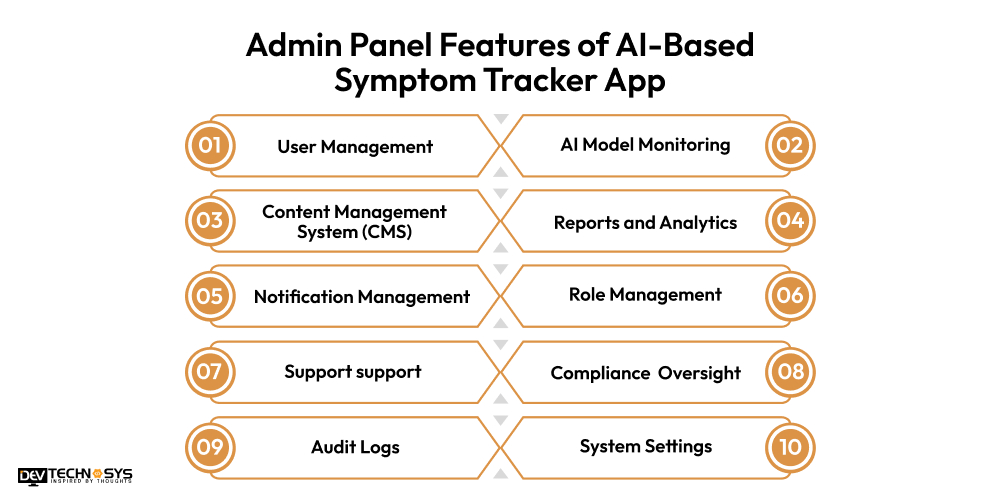
-
User Management:
It allows administrators to control and edit user information, monitor their actions, and ensure users follow the food and symptom tracker app policies.
-
AI Model Monitoring:
This ensures that the performance of the artificial natural language processing is assessed frequently so that the assessment and diagnosis of the symptoms are accurate and timely.
-
Content Management System (CMS):
It enables admins to update health articles, FAQs, and the symptom tracker app development content so that users are well-informed and engaged.
-
Reports and Analytics:
Creates detailed reports of the symptom tracking app use, user interactions, and health issues to enable evidence-based decisions.
-
Notification Management:
Helps in sending timely notifications and reminders to the users for tracking symptoms and visits.
-
Role Management:
Organises and determines roles and permissions for administrators, users, and owners to properly and effectively control the application.
-
Support Ticket System:
This feature helps the admin organize help and solve problems users prioritize quickly.
-
Compliance Oversight:
This feature ensures that all data guidelines, such as HIPAA or the GDPR, are followed to prevent legal compliance from being violated.
-
Audit Logs:
Observe the changes and actions made within the best symptom tracker app to ensure accountability and increase its operability.
-
System Settings:
It allows users to customize the app symptom tracker features, look and feel, and system performance settings.
2. User Panel Features
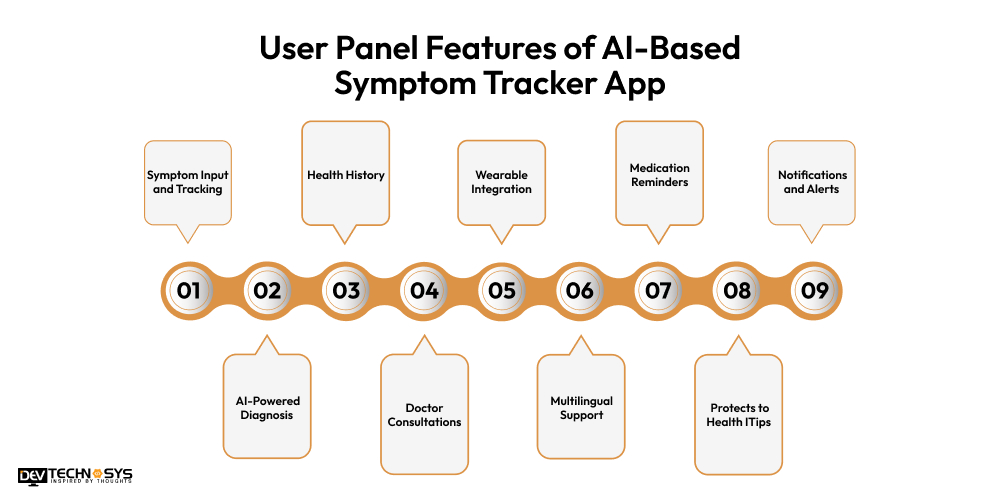
-
Symptom Input and Tracking:
It allows patients to report and describe their symptoms and health status in detail to track trends.
-
AI-Powered Diagnosis:
It offers possible diseases and related information that may help make a proper diagnosis, improving decision-making.
-
Health History:
It stores previous symptoms, diagnoses, and visits so patients can easily recall them.
-
Doctor Consultations:
Helps make bookings for virtual consultations with the doctors for a proper consultation.
-
Wearable Integration:
It integrates with health fitness data devices for the final collection of symptom monitoring purposes.
-
Multilingual Support:
Supports several languages to make service available for people of different language orientations.
-
Medication Reminders:
It helps the user remember when to offer customized information, medication, and tools, thus improving the health and health status of the login content user.
-
Protects Health Tips:
User-secure resource information by using several factors to log in or authenticate as the user, using encryption.
-
Notifications and Alerts:
Informs users about symptom monitoring, appointments, and health information to improve user participation with the best symptom checker app.
3. Owner Panel Features
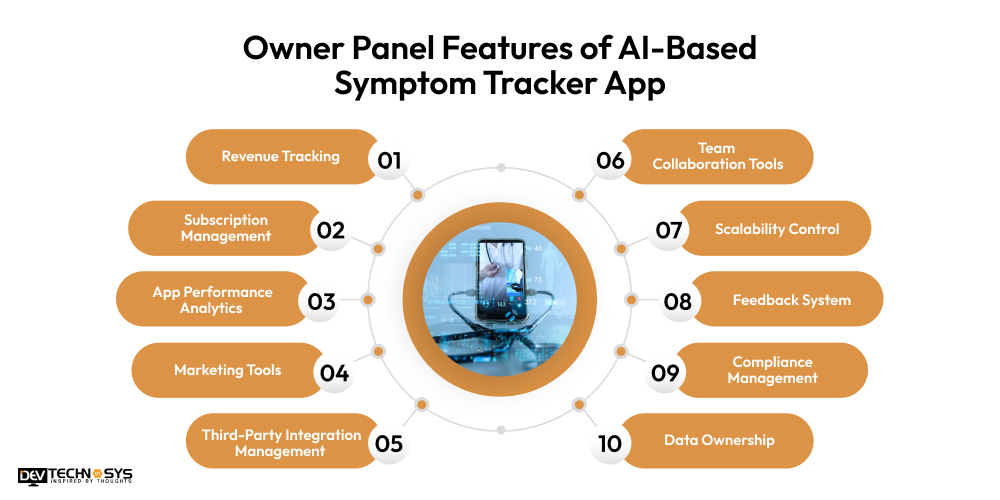
-
Revenue Tracking:
This includes examining the income from subscriptions, consultative services, and advertising to assess the economic outcome.
-
Subscription Management:
Supervises subscription plans, billing periods, and subscription product payments to enhance revenue collection.
-
App Performance Analytics:
It also checks the app for symptom checker rate, overall uptime, and user feedback to ensure the app is properly working.
-
Marketing Tools:
It supports creating and managing campaigns and tracking campaigns for app for symptom checker marketing and user acquisition.
-
Third-Party Integration Management:
Manages the integration with other healthcare organizations and labs, as well as the payment gateway integrations for quality service delivery.
-
Team Collaboration Tools:
Allows for effective communication and assigning tasks to various team members.
-
Scalability Control:
Manage the servers and other resources to accommodate the growth of the users and optimize the server settings.
-
Feedback System:
Gather and analyze the users’ feedback to improve the product or service.
-
Compliance Management:
Ensures that all legal and regulatory requirements are adhered to in the app to avoid violations.
-
Data Ownership:
Controls the user data and analytics data collected in a way that is beneficial for the organization.
AI-Based Symptom Tracker App Development Cost
The symptom tracker app development cost varies depending on implications based on the team, functions, and complexity and size of many other factors.
The total cost to develop an AI-based symptom tracker app can vary from $8000 to $30000, depending on the functionalities, the size of the healthcare app development company, and other factors. To help you a little bit more, I have explained all of those factors below:
Key Factors Affecting the Cost:
1. Features and Functionalities
The healthcare app development cost is relatively low for the basic functionalities (symptom input and AI diagnosis). At the same time, the cost is high for complex features such as voice assistance, integrated wearable devices, and multiple languages.
Feature/Functionality |
Cost Range |
| Basic Features (Symptom Input) | $3,000 – $8,000 |
| AI Diagnosis | $5,000 – $10,000 |
| Advanced Features (Voice Assist) | $8,000 – $15,000 |
| Wearable Device Integration | $5,000 – $12,000 |
| Multilingual Support | $5,000 – $10,000 |
2. AI and Machine Learning Integration
The creation or incorporation of AI models for symptom evaluation is costly. The overall symptom tracker app development cost depends on the algorithms’ sophistication, the data set’s quality, and the processing power available.
AI Component |
Cost Range |
| AI Algorithm Development | $8,000 – $20,000 |
| Data Collection and Training | $5,000 – $12,000 |
| Model Testing and Optimization | $3,000 – $8,000 |
| Natural Language Processing | $6,000 – $15,000 |
3. UI/UX Design
Good UI and a good-looking design make the user more comfortable and engaged with the application. Custom designs are more expensive than the standard templates, affecting the overall symptom tracker app development cost.
Design Element |
Cost Range |
| Basic Templates | $2,000 – $5,000 |
| Custom Design | $5,000 – $12,000 |
| User Testing and Feedback | $2,000 – $5,000 |
| Accessibility Features | $3,000 – $6,000 |
4. Platform Choice
The mobile app development cost also varies when developing a single-platform application, such as all Android platforms or iOS. However, due to multiple integrations and security, the symptom tracker application development cost may increase if you choose iOS over Android.
Platform |
Cost Range |
| Android | $5,000 – $15,000 |
| iOS | $8,000 – $20,000 |
| Cross-Platform | $15,000 – $30,000 |
5. Team Location Expensive
The overall symptom tracker app development cost depends on the application and the project’s location. It is important to note that symptom tracker app development companies in North America or Europe are more costly than developers in Asia or Eastern Europe.
Region |
Hourly Rate |
| North America | $80 – $200/hour |
| Europe | $50 – $150/hour |
| Asia | $20 – $80/hour |
| Eastern Europe | $30 – $100/hour |
6. Compliance and Security
The symptom tracker application development cost also varies for apps in the healthcare sector that have to meet specific legal requirements. Data privacy and protection, such as the HIPAA or the GDPR, increases the cost of development and testing.
Compliance Factor |
Cost Range |
| HIPAA Compliance | $5,000 – $12,000 |
| GDPR Compliance | $3,000 – $10,000 |
| Data Encryption | $2,000 – $6,000 |
| Penetration Testing | $4,000 – $8,000 |
7. Maintenance and Updates
The symptom tracker application development cost includes post-launch support, such as bug fixes, upgrades, and new features, which are never-ending costs that should be considered.
Post-Launch Service |
Cost Range (Annual) |
| Bug Fixes | $1,000 – $5,000 |
| Feature Enhancements | $3,000 – $10,000 |
| Performance Optimization | $2,000 – $8,000 |
| Regular Updates | $3,000 – $10,000 |
The symptom tracker app development cost varies depending on the number of features, the level of AI, the design, the platform, the doctor on-demand app development company location, the level of compliance, and the necessary maintenance.
Simplified applications are inexpensive, but implementing more elaborate functions, such as AI-driven diagnosis, wearable device connections, and meeting legal requirements, increases the time and symptom tracker application development cost.
How Does An AI Symptom Tracker Application Make Money?
Many people want to invest in symptom tracker application development but need to learn how to make money. Artificial intelligence users can identify symptoms and may suggest possible diseases or treatments. These apps generally offer their services for free, but they can make money from tips:
1. Premium Subscriptions:
Like any other digital service, symptom tracker apps may offer premium subscriptions. These subscriptions provide other services such as premium symptom analysis, health plans, and fast access to health care professionals. Users are willing to subscribe to a monthly or annual service to gain access to better services and content.
2. Data and Partnerships:
App users provide a lot of helpful health information. This data can be identified, removed from information, and organized into patterns for the benefit of pharmaceutical companies, healthcare organizations, and scientists. Thus, healthcare app developers can sell or license this data to these organizations and earn decent revenue.
3. Telehealth Integrations:
Some symptom tracker apps also offer the option of consulting with healthcare professionals, where the consultation is done through the app. The ai app development company can get a commission or a referral fee for every telehealth consultation done through their application. It is important to note that this integration is beneficial to the users and is a way of
4. Advertising:
Generating banner revenue advertisements is rare in healthcare applications, but it is a symptom tracker app development of monetization. It may show ads for drugs, health supplies, or fitness products & services targeting the user’s profile and symptoms. However, ads should be served to the user in a non-disturbing manner to ensure that the user does not get misled.
5. Direct-to-Consumer Health Products:
Sometimes, symptom tracker apps act as vendors and sell their products, such as supplements or fitness gadgets. Such products can be easily incorporated into the app, which may help build user trust. The app may also earn from providing these products to the users, increasing the app’s brand reputation.
How Can Our Partner Dev Technosys Assist in Creating Your AI-based Symptom Tracker App?
Dev Technosys can assist in creating an AI-based symptom tracker app through the company’s mobile application development and AI integration services. Our artificial intelligence development services providers will help you with the whole process, from the idea stage to the stage where the app is fully implemented.
We will work on a high-quality interface, develop the symptom-tracking functionality, and incorporate a sophisticated AI to identify symptoms and offer health recommendations. With Dev Technosys, you can create a quality symptom tracker application that will enable people to manage their health through the use of the application.
Frequently Asked Questions
1. How Much Does It Develop an AI-based Symptom Tracker App?
The symptom tracker app development company size, complexity, capabilities, platform, and level can all have a sizable effect on the cost to create an AI-based symptom tracker app. A more complex app should cost over $23,000, while a less complicated one might cost about $15000.
2. How Long Does It Take To Develop an AI-based Totally Symptom Tracker App?
An AI-based totally symptom tracker software program commonly takes 3 to 6 months to create. This can also vary, though, depending on the program’s intricacy, the dimensions of the development company , and any problems that can arise at some development point.
3. Why Choose Dev Technosys to Develop an AI-based Symptom Tracker App?
- Experienced team in AI and healthcare app development.
- Proven track record of delivering high-quality, user-centric apps.
- Expertise in AI model development and data analysis.
- Commitment to data privacy and security.
4. What Are The Benefits of Developing an AI-based Symptom Tracker App?
- Improved user health outcomes through early symptom detection.
- Personalized health recommendations and insights.
- Reduced healthcare costs by preventing serious illnesses.
- Enhanced patient-doctor communication.
5. How Can You Monetize AI-based Symptom Tracker App?
- Premium subscriptions for advanced features.
- In-app purchases for additional functionalities.
- Advertising revenue from targeted ads.
- Data monetization (anonymized and aggregated data).
- Partnerships with healthcare providers and pharmaceutical companies.
6. How Much Will It Cost To Maintain Your AI-based Symptom Tracker App?
The complexity of the software, how often it is updated, and the need for technical assistance all affect the cost of building an AI-based symptom tracker app. Ongoing maintenance expenses usually fall between $2000 and $5,000 a month.
